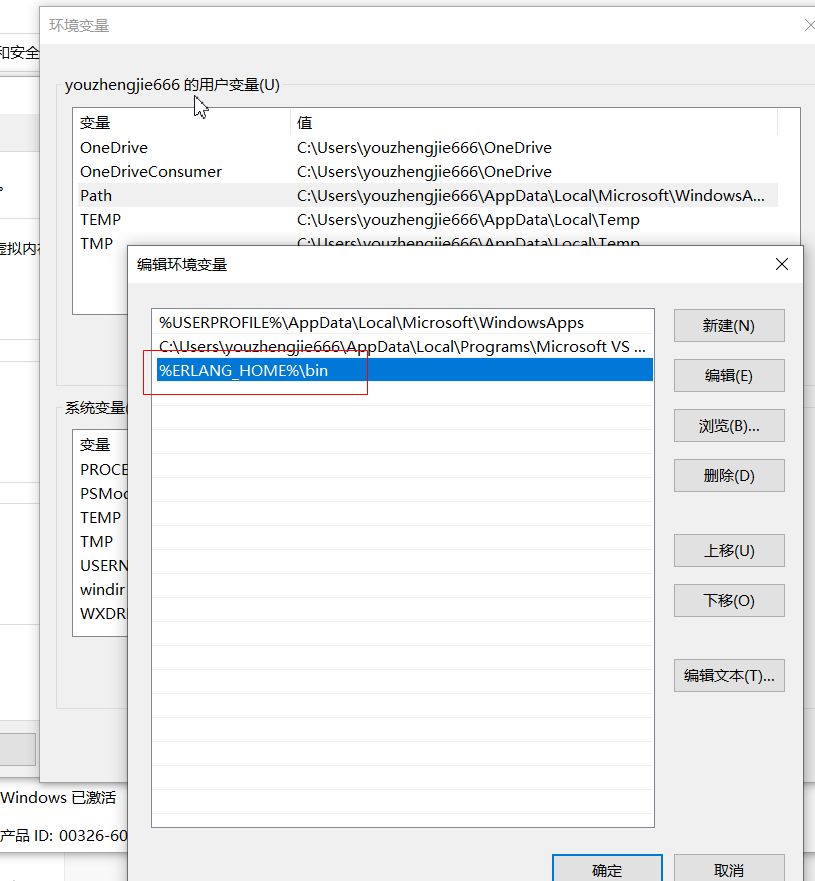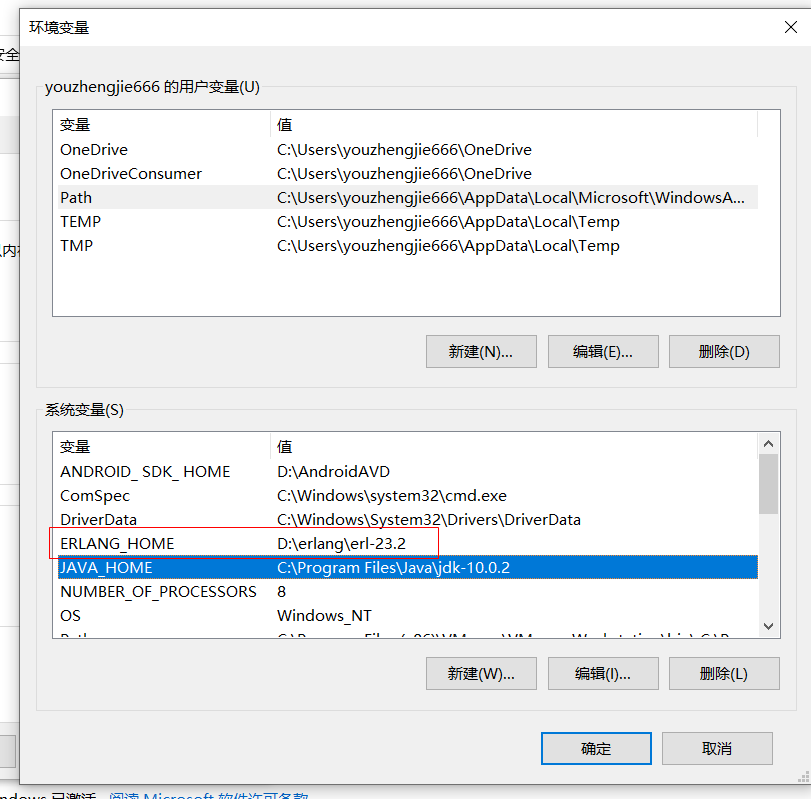必学消息队列-RabbitMQ(上集)
个人简介
作者是一个来自河源的大三在校生,以下笔记都是作者自学之路的一些浅薄经验,如有错误请指正,将来会不断的完善笔记,帮助更多的Java爱好者入门。
@[toc]
RabbitMQ(上集)
什么是RabbitMQ
MQ全称为Message Queue, 消息队列(MQ)是一种应用程序对应用程序的通信方法。应用程序通过读写出入队列的消息(针对应用程序的数据)来通信,而无需专用连接来链接它们。消息传递指的是程序之间通过在消息中发送数据进行通信,而不是通过直接调用彼此来通信,直接调用通常是用于诸如远程过程调用的技术。排队指的是应用程序通过 队列来通信。队列的使用除去了接收和发送应用程序同时执行的要求。
MQ的特点
- MQ是消费-生产者模型的一个典型的代表,一端往消息队列中不断写入消息,而另一端则可以读取或者订阅队列中的消息。
- MQ遵循了AMQP协议的具体实现和产品。
MQ的使用场景
各种MQ对比
在目前主流的消息队列中有(ActiveMQ,RocketMQ,RabbitMQ,kafka)
RabbitMQ在上面的各种消息队列中对于消息的保护是十分到位的(不会丢失消息),相对于kafka,虽然kafka性能十分强悍,在大数据中处理海量数据游刃有余,但是kafka容易丢失消息,而RabbitMQ虽然性能不及kafka,但是也不会很差,对于消息要求完整性很高的系统中用RabbitMQ十分好。
安装RabbitMQ环境
总教程:https://www.cnblogs.com/saryli/p/9729591.html
1.安装erlang
(1.)下载erlang
下载教程:https://www.cnblogs.com/minily/p/7398445.html
(2.)配置erlang环境
配置教程:https://blog.csdn.net/g6256613/article/details/80191402
需要配置环境变量


(3.)检查是否安装成功
打开cmd,输入erl,有输出说明成功
(4.)下载rabbitMQ
下载地址:https://www.cnblogs.com/saryli/p/9729591.html
。。。。。。。。。。。。省略,在总教程都有。
(5.)最后访问http://localhost:15672,如果访问成功,说明rabbitMQ安装成功
RabbitMQ的5种模型(重点)
导入依赖
<dependency>
<groupId>com.rabbitmq</groupId>
<artifactId>amqp-client</artifactId>
<version>5.7.3</version>
</dependency>
基本消息模型(hello world)
生产者
public class provider {
/**
* 最基本的消息队列模型
*
* 消息生产者
* @param args
*/
public static void main(String[] args) throws IOException, TimeoutException {
//1.先new一个连接工厂
ConnectionFactory factory = new ConnectionFactory();
//定义指定rabbitmq配置的工厂
factory.setUsername("ems");
factory.setPassword("123456");
factory.setVirtualHost("/ems"); //虚拟主机
factory.setHost("127.0.0.1"); //rabbitMQ的主机名(ip)
//2.通过连接工厂创建一个connection
Connection connection = factory.newConnection();
//3.通过connection对象create一个channel通道,以后我们的操作就是channel
Channel channel = connection.createChannel();
//4.声明队列,如果没有这个队列则会自动生成
/**
* queueDeclare(String queue, boolean durable, boolean exclusive, boolean autoDelete, Map<String, Object> arguments)
* 参数1:队列名字
* 参数2:队列是否持久化
* 参数3:是否排斥(也就是一个队列是否只能由一个消费者消费)
* 参数4:自动删除,当所有消费者消费完之后是否把队列删除
* 参数5:额外参数
*/
channel.queueDeclare("hello",true,false,false,null);
//5.发布消息
/**
* 参数1:交换机名称,空字符串代表使用默认交换机。。。。
* 参数2:路由键(在没有指定交换机的情况下(不包括空字符串),路由键是发送消息队列的名字
* 参数3:额外参数===通常用MessageProperties.PERSISTENT_TEXT_PLAIN,意思是发送的消息在没有消费完也能持久化
* *****参数4(最重要):发送的消息内容(要转换成byte类型)
*/
channel.basicPublish("","hello", MessageProperties.PERSISTENT_TEXT_PLAIN,"第一个RabbitMQ程序!!!".getBytes());
channel.close();
connection.close();
}
}
消费者
public class comsumer {
/**
* 消息消费者
*/
public static void main(String[] args) throws IOException, TimeoutException {
ConnectionFactory connectionFactory = new ConnectionFactory();
connectionFactory.setUsername("ems");
connectionFactory.setPassword("123456");
connectionFactory.setVirtualHost("/ems");
connectionFactory.setHost("127.0.0.1");
Connection connection = connectionFactory.newConnection();
Channel channel = connection.createChannel();
//这里的配置参数一定要和生产者一模一样,不然会报错
channel.queueDeclare("hello",true,false,false,null);
//进行消费
/**
* 参数1:队列名字
* 参数2:是否自动确认消息
* 参数3:通常用DefaultConsumer匿名内部类,实现handleDelivery接收消息
*/
channel.basicConsume("hello",true,new DefaultConsumer(channel){
/**
*参数3:接收的消息
*/
@Override
public void handleDelivery(String consumerTag, Envelope envelope, AMQP.BasicProperties properties, byte[] body) throws IOException {
System.out.println("=======消费者取出消息===>"+new String(body));
}
});
/**
* 消费者端最好不要关闭channel和connection,不然可能读取不到消息
*/
// channel.close();
// connection.close();
}
}
work queue模型
为什么会引入这么一个消息队列模型????
我们可以想象一下,如果按照第一个模型,点对点的,生产者发消息经过消息队列再到消费者,此时消费者只有1个,如果我们生产者发送60条消息,假设每条消息要1秒钟才能执行完,那么hello world模型就要60秒才能消费完所有消息,如果我们用workqueue模型呢,我们假如再引入一个消费者,也就是1个生产者发送60条信息到2个消费者,默认负载均衡,每个队列处理30条,而且还是异步处理,那么我们只需要30秒就处理好了,效率大大的提高
未实现能者多劳机制
public class provider {
/**
* 生产者
* ====workQueue模型
*/
public static void main(String[] args) throws IOException, TimeoutException {
ConnectionFactory connectionFactory = new ConnectionFactory();
connectionFactory.setHost("127.0.0.1");
connectionFactory.setUsername("ems");
connectionFactory.setPassword("123456");
connectionFactory.setVirtualHost("/ems");
Connection connection = connectionFactory.newConnection();
Channel channel = connection.createChannel();
//生产者声明了队列,消费者也都要声明
channel.queueDeclare("workqueue",true,false,false,null);
//basicPublish(String exchange, String routingKey, BasicProperties props, byte[] body)
for (int i = 0; i < 10; i++) {
channel.basicPublish("","workqueue",null,("hello=="+i+"").getBytes());
}
channel.close();
connection.close();
}
}
public class comsumer1 {
/**
* 消费者1
* @param args
*/
public static void main(String[] args) throws IOException, TimeoutException {
ConnectionFactory connectionFactory = new ConnectionFactory();
connectionFactory.setVirtualHost("/ems");
connectionFactory.setUsername("ems");
connectionFactory.setPassword("123456");
connectionFactory.setHost("127.0.0.1");
Connection connection = connectionFactory.newConnection();
Channel channel = connection.createChannel();
//queueDeclare(String queue, boolean durable, boolean exclusive, boolean autoDelete, Map<String, Object> arguments)
channel.queueDeclare("workqueue",true,false,false,null);
//basicConsume(String queue, boolean autoAck, Consumer callback)
channel.basicConsume("workqueue",true,new DefaultConsumer(channel){
@Override
public void handleDelivery(String consumerTag, Envelope envelope, AMQP.BasicProperties properties, byte[] body) throws IOException {
System.out.println("===comsumer1===>"+new String(body));
}
});
}
}
public class comsumer2 {
/**
* 消费者2
*/
public static void main(String[] args) throws IOException, TimeoutException {
ConnectionFactory connectionFactory = new ConnectionFactory();
connectionFactory.setVirtualHost("/ems");
connectionFactory.setHost("127.0.0.1");
connectionFactory.setUsername("ems");
connectionFactory.setPassword("123456");
Connection connection = connectionFactory.newConnection();
Channel channel = connection.createChannel();
channel.queueDeclare("workqueue",true,false,false,null);
channel.basicConsume("workqueue",true,new DefaultConsumer(channel){
@Override
public void handleDelivery(String consumerTag, Envelope envelope, AMQP.BasicProperties properties, byte[] body) throws IOException {
System.out.println("===comsumer2===>"+new String(body));
}
});
}
}
输出结果:(默认是类似负载均衡的轮询算法)
===comsumer1===>hello==0
===comsumer1===>hello==2
===comsumer1===>hello==4
===comsumer1===>hello==6
===comsumer1===>hello==8
实现了能者多劳机制
要实现能者多劳,只需要在消费者修改几处代码即可
1. channel.basicQos(1);
2. channel.basicConsume(“workqueue”,false,new DefaultConsumer(channel)
3. channel.basicAck(envelope.getDeliveryTag(),false); //手动确认
public class comsumer1 {
/**
* 消费者1 能者多劳
* @param args
*/
public static void main(String[] args) throws IOException, TimeoutException {
ConnectionFactory connectionFactory = new ConnectionFactory();
connectionFactory.setVirtualHost("/ems");
connectionFactory.setUsername("ems");
connectionFactory.setPassword("123456");
connectionFactory.setHost("127.0.0.1");
Connection connection = connectionFactory.newConnection();
Channel channel = connection.createChannel();
//每次收到一条消息
channel.basicQos(1);
//queueDeclare(String queue, boolean durable, boolean exclusive, boolean autoDelete, Map<String, Object> arguments)
channel.queueDeclare("workqueue",true,false,false,null);
//basicConsume(String queue, boolean autoAck, Consumer callback)
channel.basicConsume("workqueue",false,new DefaultConsumer(channel){ //第二个参数修改为false,取消自动avk
@Override
public void handleDelivery(String consumerTag, Envelope envelope, AMQP.BasicProperties properties, byte[] body) throws IOException {
System.out.println("===comsumer1===>"+new String(body));
channel.basicAck(envelope.getDeliveryTag(),false); //手动确认
}
});
}
}
public class comsumer2 {
/**
* 消费者2 能者多劳
*/
public static void main(String[] args) throws IOException, TimeoutException {
ConnectionFactory connectionFactory = new ConnectionFactory();
connectionFactory.setVirtualHost("/ems");
connectionFactory.setHost("127.0.0.1");
connectionFactory.setUsername("ems");
connectionFactory.setPassword("123456");
Connection connection = connectionFactory.newConnection();
Channel channel = connection.createChannel();
//每次只能收一条消息
channel.basicQos(1);
channel.queueDeclare("workqueue",true,false,false,null);
channel.basicConsume("workqueue",false,new DefaultConsumer(channel){
@Override
public void handleDelivery(String consumerTag, Envelope envelope, AMQP.BasicProperties properties, byte[] body) throws IOException {
System.out.println("===comsumer2===>"+new String(body));
channel.basicAck(envelope.getDeliveryTag(),false); //手动确认消息
}
});
}
}
输出结果:
===comsumer1===>hello==0
===comsumer1===>hello==6
===comsumer1===>hello==8
fanout模型(广播模型)性能最好
特点:凡是和这个fanout交换机绑定的临时队列,都能收到消息
public class provider {
/**
* fanout模型(广播模型)
*
*/
public static void main(String[] args) throws IOException, TimeoutException {
ConnectionFactory connectionFactory = new ConnectionFactory();
connectionFactory.setVirtualHost("/ems");
connectionFactory.setUsername("ems");
connectionFactory.setPassword("123456");
connectionFactory.setHost("127.0.0.1");
Connection connection = connectionFactory.newConnection();
Channel channel = connection.createChannel();
//生产者声明交换机==>exchangeDeclare(String exchange, String type, boolean durable, boolean autoDelete, Map<String, Object> arguments)
/**
* exchangeDeclare:
* 参数一:交换机名字
* 参数二:交换机类型:
* 有这几种类型:"" , "fanout" , "direct" , "topic"
* 参数三:交换机是否持久化。(重启rabbitmq服务如果交换机没有删除就是持久化)
* 参数四:是否自动删除
* 参数五:额外参数
*/
channel.exchangeDeclare("hello_exchange_fanout","fanout",true,false,null);
//这里不用声明消息队列,只需要声明交换机即可,消费者需要声明消息队列(临时队列)
//basicPublish(String exchange, String routingKey, BasicProperties props, byte[] body)
channel.basicPublish("hello_exchange_fanout","",null,"exchange_fanout".getBytes());
channel.close();
connection.close();
}
}
public class comsumer1 {
/**
* fanout模型(广播模型)
*
*/
public static void main(String[] args) throws IOException, TimeoutException {
ConnectionFactory connectionFactory = new ConnectionFactory();
connectionFactory.setVirtualHost("/ems");
connectionFactory.setHost("127.0.0.1");
connectionFactory.setUsername("ems");
connectionFactory.setPassword("123456");
Connection connection = connectionFactory.newConnection();
Channel channel = connection.createChannel();
//声明交换机
/**
* exchangeDeclare:
* 参数一:交换机名字
* 参数二:交换机类型:
* 有这几种类型:"" , "fanout" , "direct" , "topic"
* 参数三:交换机是否持久化。(重启rabbitmq服务如果交换机没有删除就是持久化)
* 参数四:是否自动删除
* 参数五:额外参数
*/
channel.exchangeDeclare("hello_exchange_fanout","fanout",true,false,null);
//创建一个临时队列
String queueName = channel.queueDeclare().getQueue();
//把交换机和临时队列绑定在一起
//queueBind(String queue, String exchange, String routingKey)
channel.queueBind(queueName,"hello_exchange_fanout","");
//然后就可以通信了
//basicConsume(String queue, boolean autoAck, Map<String, Object> arguments, Consumer callback)
channel.basicConsume(queueName,true,new DefaultConsumer(channel){
@Override
public void handleDelivery(String consumerTag, Envelope envelope, AMQP.BasicProperties properties, byte[] body) throws IOException {
System.out.println(new String(body));
}
});
}
}
public class comsumer2 {
public static void main(String[] args) throws IOException, TimeoutException {
ConnectionFactory connectionFactory = new ConnectionFactory();
connectionFactory.setVirtualHost("/ems");
connectionFactory.setHost("127.0.0.1");
connectionFactory.setUsername("ems");
connectionFactory.setPassword("123456");
Connection connection = connectionFactory.newConnection();
Channel channel = connection.createChannel();
channel.exchangeDeclare("hello_exchange_fanout","fanout",true,false,null);
String queueName = channel.queueDeclare().getQueue();
channel.queueBind(queueName,"hello_exchange_fanout","");
channel.basicConsume(queueName,true,new DefaultConsumer(channel){
@Override
public void handleDelivery(String consumerTag, Envelope envelope, AMQP.BasicProperties properties, byte[] body) throws IOException {
System.out.println(new String(body));
}
});
}
}
direct模型(直连)(默认)
特点:根据路由键直接匹配
fanout、direct、topic 交换机类型都是可以把同一条消息路由到多个消费者身上的。而hello world、work queue不行。work queue和hello world模型同一条消息只能路由到某一个消费者身上
public class provider {
/**
* direct模式(直连交换机)
* @param args
*/
public static void main(String[] args) throws IOException, TimeoutException {
ConnectionFactory connectionFactory = new ConnectionFactory();
connectionFactory.setVirtualHost("/ems");
connectionFactory.setHost("127.0.0.1");
connectionFactory.setUsername("ems");
connectionFactory.setPassword("123456");
Connection connection = connectionFactory.newConnection();
Channel channel = connection.createChannel();
channel.exchangeDeclare("direct_exchange","direct",true,false,null);
/**
* 参数2:路由键,如果消费者有符合的则可以接收消息
*/
channel.basicPublish("direct_exchange","user_log", MessageProperties.PERSISTENT_TEXT_PLAIN,
"hello,direct".getBytes());
channel.close();
connection.close();
}
}
public class comsumer1 {
public static void main(String[] args) throws IOException, TimeoutException {
ConnectionFactory connectionFactory = new ConnectionFactory();
connectionFactory.setVirtualHost("/ems");
connectionFactory.setHost("127.0.0.1");
connectionFactory.setUsername("ems");
connectionFactory.setPassword("123456");
Connection connection = connectionFactory.newConnection();
Channel channel = connection.createChannel();
channel.exchangeDeclare("direct_exchange","direct",true,false,null);
String queueName = channel.queueDeclare().getQueue();
//可以绑定多个路由,只要符合一个就可以接收到消息
channel.queueBind(queueName,"direct_exchange","user_log");
// channel.queueBind(queueName,"direct_exchange","user_money");
channel.basicConsume(queueName,true,new DefaultConsumer(channel){
@Override
public void handleDelivery(String consumerTag, Envelope envelope, AMQP.BasicProperties properties, byte[] body) throws IOException {
System.out.println("comsumer1===>"+new String(body));
}
});
}
}
public class comsumer2 {
public static void main(String[] args) throws IOException, TimeoutException {
ConnectionFactory connectionFactory = new ConnectionFactory();
connectionFactory.setVirtualHost("/ems");
connectionFactory.setHost("127.0.0.1");
connectionFactory.setUsername("ems");
connectionFactory.setPassword("123456");
Connection connection = connectionFactory.newConnection();
Channel channel = connection.createChannel();
channel.exchangeDeclare("direct_exchange","direct",true,false,null);
String queueName = channel.queueDeclare().getQueue();
//可以绑定多个路由,只要符合一个就可以接收到消息
// channel.queueBind(queueName,"direct_exchange","user_log");
channel.queueBind(queueName,"direct_exchange","user_money");
channel.basicConsume(queueName,true,new DefaultConsumer(channel){
@Override
public void handleDelivery(String consumerTag, Envelope envelope, AMQP.BasicProperties properties, byte[] body) throws IOException {
System.out.println("comsumer2===>"+new String(body));
}
});
}
}
topic模型(通配符)
特点:通配符(#号和*号),也可以不使用通配符。
public class provider {
/**
* topic模式
* topic和direct相比,基本差不多,只不过topic可以使用通配符进行匹配
* 在topic模式下,生产者发送的路由键是user.log.test,消费者可以用user.#或者#.log.test或者*.*.test 。。。等等来匹配
* #:代表一个或多个单词的占位符
* *:代表一个单词的占位符,如上面,user.*是匹配不了user.log.test的。。。。。
* 交换机性能:fanout>direct>topic
*/
public static void main(String[] args) throws IOException, TimeoutException {
ConnectionFactory connectionFactory = new ConnectionFactory();
connectionFactory.setVirtualHost("/ems");
connectionFactory.setHost("127.0.0.1");
connectionFactory.setUsername("ems");
connectionFactory.setPassword("123456");
Connection connection = connectionFactory.newConnection();
Channel channel = connection.createChannel();
channel.exchangeDeclare("topic_exchange","topic",true,false,null);
for (int i = 0; i < 10; i++) {
String msg="topic_hello_"+i;
channel.basicPublish("topic_exchange","log.order.money", MessageProperties.PERSISTENT_TEXT_PLAIN,msg.getBytes());
}
channel.close();
connection.close();
}
}
public class consumer1 {
public static void main(String[] args) throws IOException, TimeoutException {
ConnectionFactory connectionFactory = new ConnectionFactory();
connectionFactory.setVirtualHost("/ems");
connectionFactory.setHost("127.0.0.1");
connectionFactory.setUsername("ems");
connectionFactory.setPassword("123456");
Connection connection = connectionFactory.newConnection();
Channel channel = connection.createChannel();
String queueName = channel.queueDeclare().getQueue();
channel.exchangeDeclare("topic_exchange","topic",true,false,null);
channel.queueBind(queueName,"topic_exchange","log.order.money");
channel.basicConsume(queueName,true,new DefaultConsumer(channel){
@Override
public void handleDelivery(String consumerTag, Envelope envelope, AMQP.BasicProperties properties, byte[] body) throws IOException {
System.out.println("consumer1==>"+new String(body));
}
});
}
}
public class consumer2 {
public static void main(String[] args) throws IOException, TimeoutException {
ConnectionFactory connectionFactory = new ConnectionFactory();
connectionFactory.setVirtualHost("/ems");
connectionFactory.setHost("127.0.0.1");
connectionFactory.setUsername("ems");
connectionFactory.setPassword("123456");
Connection connection = connectionFactory.newConnection();
Channel channel = connection.createChannel();
String queue = channel.queueDeclare().getQueue();
channel.exchangeDeclare("topic_exchange","topic",true,false,null);
/**
* log.#===>#代表后面可以有一个或多个。
* log,* ==>代表后面只能有一个,也就是类似log.xx 才能匹配上
*/
channel.queueBind(queue,"topic_exchange","log.#");
channel.basicConsume(queue,true,new DefaultConsumer(channel){
@Override
public void handleDelivery(String consumerTag, Envelope envelope, AMQP.BasicProperties properties, byte[] body) throws IOException {
System.out.println("consumer2====>"+new String(body));
}
});
}
}
- 点赞
- 收藏
- 关注作者


评论(0)